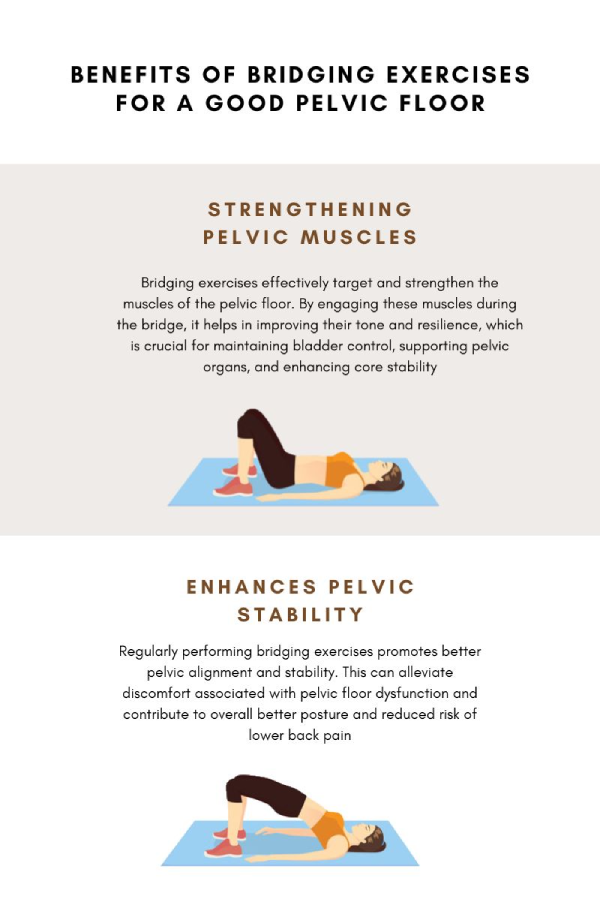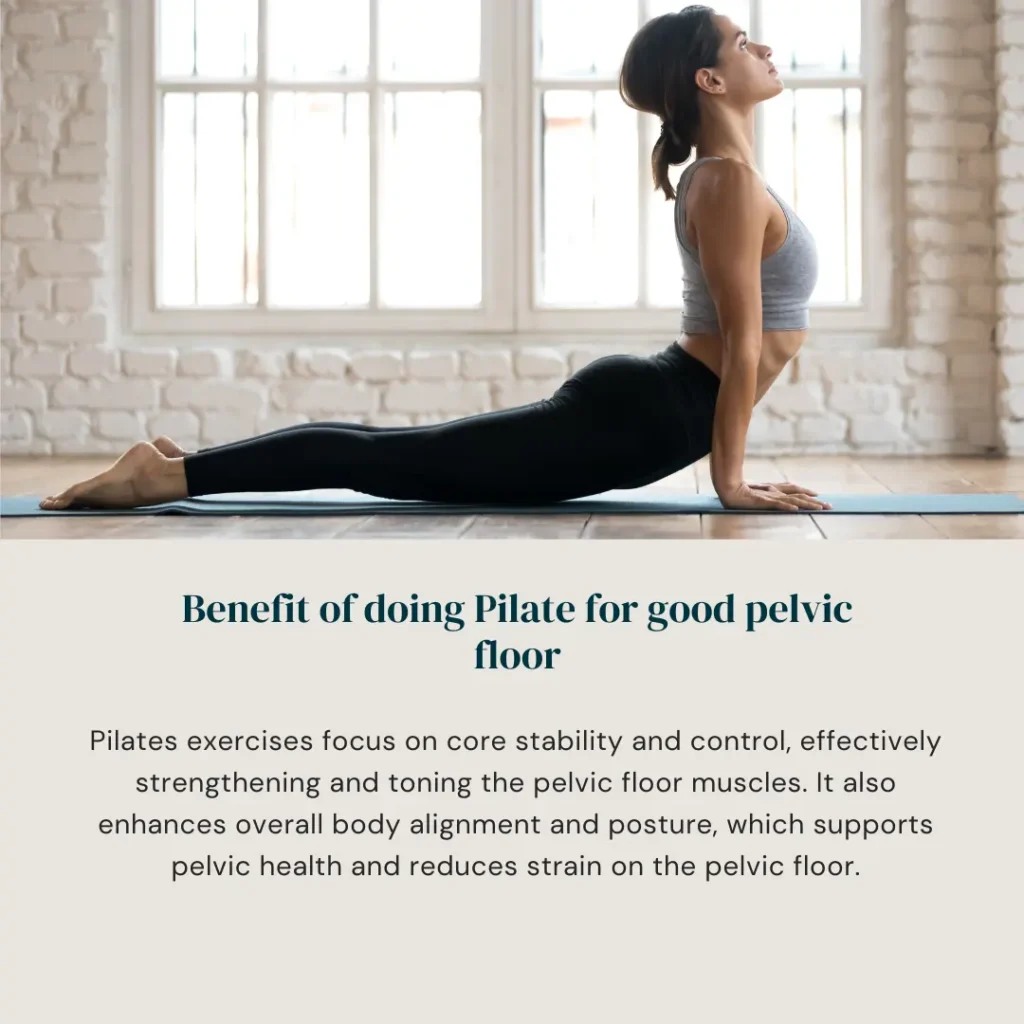During pregnancy, maintaining pelvic floor health is crucial for overall well-being and preparing for childbirth. Pelvic floor exercises during pregnancy, also known as Kegel exercises, play a pivotal role in strengthening the muscles that support the bladder, uterus, and bowels. These exercises involve contracting and relaxing the pelvic floor muscles, which can help to prevent urinary incontinence, support the growing uterus, and facilitate postpartum recovery. This article will help to elaborate on the importance and benefits of pelvic floor exercises during pregnancy.
Pelvic floor exercise can be started before, during, and after pregnancy. It is the name given to a set of muscles that support your uterus, bladder, and colon that extend like a frame from the pubic bone to the tailbone.
Pregnancy is a time to strengthen the pelvic floor because it prepares the body for carrying and giving birth. Additionally, strong pelvic floor muscles reduce the incidence of urine incontinence, which mostly occurs during and after pregnancy.
How come pelvic floor exercises are essential?
Exercises targeting the pelvic floor are crucial for improving sexual function and preventing bladder and bowel issues, including prolapse and incontinence, at any age.
Hormonal changes during pregnancy soften and make muscles easier to stretch. The weight of your developing baby and these changes further strain the pelvic floor, which may raise the risk of bladder or gastrointestinal issues developing both during and after pregnancy.
One in three women experience some incontinence after giving birth. Still, your pelvic floor is more likely to return to normal after giving birth if you receive pelvic floor training both during and after your pregnancy.
Why is pelvic floor exercise during pregnancy important?
At any age, pelvic floor exercises during pregnancy are essential for enhancing sexual function and avoiding problems with the bladder and intestines, such as prolapse and incontinence.
Pregnancy-related hormonal changes cause your muscles to soften and stretch more easily. The weight of your growing child further strains the pelvic floor, and these adjustments increase the likelihood of developing gastrointestinal or bladder problems during and after pregnancy.
After giving birth, one in three women experience incontinence of some form; however, if you undergo pelvic floor training both during and after your pregnancy, your pelvic floor is more likely to return to normal.
How to perform Kegels correctly?
The kegel exercise is the basic method of strengthening the pelvic floor muscles and is also one of the most popular. In general, anyone can benefit from performing kegel exercises. However, it’s important to remember to use both your core abdominal muscles and your pelvic floor muscles.
Finding and feeling those pelvic floor muscles should be your initial step. Try visualising the muscles between your legs that run from your hip bones on both sides to your tailbone in the back and pelvic bone in the front. You can lie down, sit, or stand, depending on what is most comfortable for you.
If you aren’t feeling the lift as much, your muscles may be really weak or tense. Some people need some practice to feel the lift and squeeze. You want to use your lower abdominal and pelvic floor muscles as you squeeze and lift them. To accomplish this, try to squeeze your abdomen forward towards your spine.
Ensuring the muscles in the lower abdomen contract during Kegel exercises is essential. There shouldn’t be any pain or discomfort when you use your core and pelvic floor muscles. You may need to stretch more before if there is pain or you are not seeing any improvement. It’s also possible that you’re not performing the squeeze correctly or if other muscles,
How do you perform pelvic floor exercises during pregnancy?
- Firm the muscles in your pelvic floor. Inside, you should feel the muscles surrounding your vagina and anus lifting.
- For as long as you can, or until you count to five, hold them as tightly as you can.
- Let your muscles relax. After letting go and relaxing for around five seconds, you should feel them do so.
- Do the exercise as often as you are able.
- As you perform the exercises, make sure your buttocks and thighs remain loose and that you are not holding your breath.
- Try to complete three sets of 8–12 squeezes each day. You can experiment with performing sets while sitting, standing, or lying down.
What time of day is ideal for pelvic floor exercises?
Exercises for the pelvic floor can be done at any time of day. These can be performed at any location and any angle.
Squeeze your pelvic floor firmly whenever you cough, sneeze, or lift something heavy. After giving birth, your body needs time to heal, including the muscles and nerves in your pelvic region, which may have been strained during the birth of your child, and your pelvic floor. Recovery time may increase for women who give birth to a large baby, push for an extended period, or use assisted birth.
Strengthening exercise for the pelvic floor during pregnancy
Squeeze every muscle in your lower body simultaneously, as if you were: removing a poop, holding a tampon in your vagina, or halting the flow of urine. When performing the exercises, try counting to ten before releasing the tension.
As you work out, keep in mind that you should breathe normally. If feasible, do three sets of these exercises each day. To aid with memory, you may do them simultaneously with anything else you do frequently, such as preparing a meal, waiting for the bus, or waiting for the kettle to boil.
Additionally, you may find that tightening your pelvic floor before coughing or sneezing helps.
Squats
Squats can also strengthen bones and joints and increase mobility. It also strengthens your lower body and aids in improving pelvic stability.
- Stand with your feet shoulder-width apart.
- Bend your knees to lower your body and stand back up. Perform sets of ten to fifteen repetitions of this exercise.
Bridging
Another good pelvic floor exercise is the bridge, which indirectly strengthens the pelvic floor by focusing on the glutes, hamstrings, and lower back.
- You perform a bridge by lying on your back with your knees bent and your feet flat on the floor.
- Raise your hips off the floor so that your shoulders and knees are in a straight line. After lowering, repeat ten to fifteen times.

Pilates
You can improve your bladder control by doing Pilates exercises, and yoga poses like cat-cow and child’s pose.
“Breathing, body awareness, and slow, deliberate movements that activate the pelvic floor are the main components of these practices.”

Training for resistance brands
Because resistance band training opposes traditional exercises, it can be a very effective way to strengthen pelvic floor muscles.
Adding resistance bands to your regular workout regimen will help you achieve far better control over your bladder.
Breathing techniques
Enhancing pelvic floor strength can be achieved subtly yet effectively with breathing exercises such as diaphragmatic breathing. Breathe deeply through your nose, letting your diaphragm expand, and then gently expel through your mouth to practise diaphragmatic breathing. When you exhale, concentrate on relaxing your pelvic floor.
Including these other exercises and approaches to help with bladder control and pelvic floor health can benefit your everyday routine.
- Pay attention to your body and begin by progressively increasing the volume and intensity of your workouts.
- Keep in mind that maintaining consistency is essential to getting long-lasting effects.
Some Advice for Kegel Exercise
- Kegel exercises should not be performed while urinating, which may hinder complete bladder emptying.
- Maintain a relaxed posture in your thigh, buttocks, and abdomen.
- Avoid going beyond. It’s common to experience discomfort in the pelvic region after beginning these workouts, but if you experience pain, stop and consult your doctor.
- It is crucial to perform these exercises regularly. If you find yourself forgetting, you can download apps that will remind you to perform your Kegels and lead you through various training sessions.
To Read More about kegel Exercises, Click here.
For certain women, contracting the pelvic floor or identifying the correct muscles can be difficult. Your doctor might suggest electrical stimulation, which employs painless electric stimulation, or biofeedback training, which helps determine which muscles are clenched.



